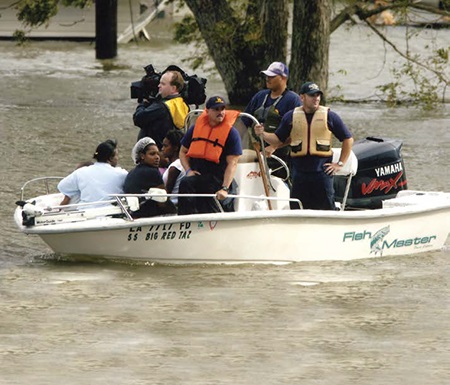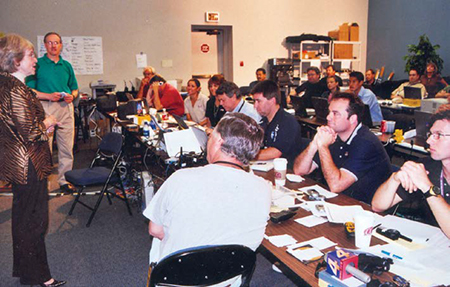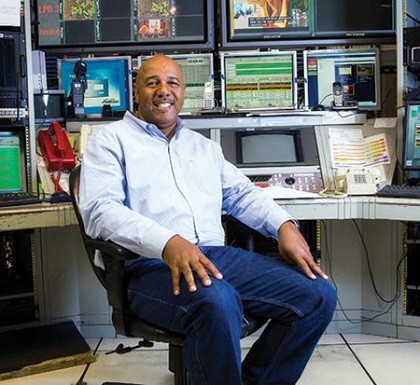Katrina: 10 Years Later
BATON ROUGE, LA.—It’s been 10 years since Hurricane Katrina struck the city of New Orleans, but to Louisiana Public Broadcasting, it seems like just yesterday. When the storm hit, this statewide network of PBS member stations found itself at the epicenter of the disaster, staying on the air around the clock to broadcast vital emergency information.
While doing its own live reporting on its main DTV channel, LPB’s facility in the state capital of Baton Rouge also became the temporary home base of the New Orleans CBS affiliate WWL-TV4’s news team, with authorization from the Federal Communications Commission to carry WWL’s signal on one of its DTV channels. LPB also hosted hundreds of TV news reporters from around the globe to cover the story of a lifetime.

EYE OF THE STORM
In the aftermath of the storm, LPB’s resources, including space, generator power and equipment, were stretched to the max as it broadcast live press briefings, field reports, helicopter aerials and other updates on the historic flooding. Today, as LPB upgrades its master control, the focus is on reliability and stability so they can better weather events like Katrina.
“In the first few days of Katrina, we were the primary news source delivering live TV coverage, not just for our six media markets in Louisiana, but for many global media outlets that picked up our signal from our satellite transponder,” said Beth Courtney, president and CEO of LPB. “We were in constant contact with emergency responders, government officials and reporters, and we did all we could to stay on the air and send out timely life and death information.”
One of the biggest challenges involved coping with prolonged power outages and fuel shortages that prompted the engineering staff to ration diesel generator power to keep the operation running. With the installation of a Harmonic Polaris multichannel automation system, LPB Director of Engineering Clarence Copeland says their broadcast infrastructure will be resilient.
While LPB and Harmonic began the upgrade in December 2014 and the installation in June, the Polaris automation system will be installed in September, and the upgrade will be completed by October. Polaris, which offers channel-in-a-box capabilities, replaces an Avid Sundance automation system that reached its end of life. When Avid decided to discontinue the product line, LPB was forced to look for another solution.

Beth Courtney, LPB president and CEO, addresses the LPB staff in September 2005, during the aftermath of Hurricane Katrina. With the new Harmonic playout system and Spectrum media servers, Copeland said, “we’ll go from three full racks down to just one, and each of our four channels will be individually controlled by Polaris advanced automation. With its modular design, it integrates the functionality of several external components into a single playout and automation system.” Copeland added that the energy-efficient system will save LBP money and space in the network’s tech center. “This extra space would have been great to have during Katrina when we were hosting the WWL-TV broadcast news team, and hundreds of other TV news reporters, for long periods of time,” he said.
Get the TV Tech Newsletter
The professional video industry's #1 source for news, trends and product and tech information. Sign up below.
Polaris incorporates an IP file-based workflow, which will allow LPB to add channels and reconfigure easily, and distribute their program signal to air, the Web and mobile apps more efficiently. The high-density Spectrum ChannelPort integrated playout system can key multilayer graphics, logo bugs and dynamic text over live or playback video to produce rich on-air looks. LPB can also run several live tickers at once.
STREAMLINED WORKFLOW
Prior to Katrina, LPB had already begun centralizing its operations. Now, according to Andy Warman, Harmonic’s director of product line management of media servers and storage for Harmonic, “with this IP-driven channel-in-a-box approach, they will dramatically simplify their equipment, system management and broadcast chain.
“When disaster struck during Katrina, LPB turned to us for technical help and we quickly resolved their issues. And because of that, they were able to stay on the air.”
During Katrina, LPB had been using Omneon playout servers, and Omneon tech support helped LPB reconfigure their servers to allow separate media playback for New Orleans CBS affiliate WWLTV4 in a way that would not adversely affect LPB’s operations.

LPB Director of Engineering Clarence Copeland in the network’s new master control. Harmonic bought Omneon in 2010, to add production and playout solutions to its portfolio. According to Copeland, “One of the reasons we chose Harmonic [for our master control upgrade] is the relationship we built with the tech support and sales people. [When Harmonic bought Omneon] it was only a company name change to us since the people who knew our system stayed in place, which made it easy to continue working with them.”
Copeland added that, after nine years of using the Omneon server, “we knew the product was solid. We also knew that this was what PBS was using at their corporate headquarters and we modeled our operation after theirs. When the PBS Interconnect V5 NGIS was introduced for file-based distribution, we were the first PBS station to air NGIS file-based programs on March 4, 2011.”
LPB has produced a full-length documentary about Hurricane Katrina slated to run during its pledge drive, the week of Aug. 27. The doc commemorates the 10-year anniversary of the historic event and offers a retrospective of the storm, its aftermath and the recovery.
��I’m very proud of the contribution we made during Katrina,” said Courtney, “and the way that commercial and non-commercial stations alike pulled together to serve the public. Our Katrina experience underscores the importance of local over-the-air broadcasting and the role it plays in our nation’s security.”
The Louisiana Public Broadcasting network includes WLPB-TV Baton Rouge, KLTM-TV Monroe, KLTS-TV Shreveport, KLPB-TV Lafayette, KLTL-TV Lake Charles and KLPA-TV in Alexandria, La.

